UGC NET CS 2017 Nov- paper-2
Question 1 |
If the time is now 4 O’clock, what will be the time after 101 hours from now ?
9 O’Clock | |
8 O'Clock | |
5 O’Clock | |
4 O’Clock |
Question 1 Explanation:
Per day 24 hours.
Present time given 4 O’clock.
Method-1: After 24+24+24+24=96. it means after 96 hours again time is 4 O’clock.
Remaining 5 hours. So, total 4+5=9 O’Clock
Method-2: Perform modulus operation by 24. So, 101%24=5
= Given time + modules time
= 4+5=9 O’Clock
Present time given 4 O’clock.
Method-1: After 24+24+24+24=96. it means after 96 hours again time is 4 O’clock.
Remaining 5 hours. So, total 4+5=9 O’Clock
Method-2: Perform modulus operation by 24. So, 101%24=5
= Given time + modules time
= 4+5=9 O’Clock
Question 2 |
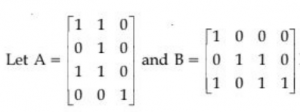
Find the boolean product A⊙B of the two matrices.
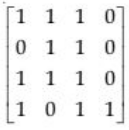 | |
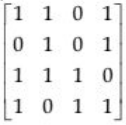 | |
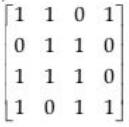 | |
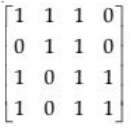 |
Question 2 Explanation:
In this problem, they given boolean product A⊙B of two matrices.
The boolean product truth table is

According to the truth table, we have to perform matrix multiplication.

The boolean product truth table is
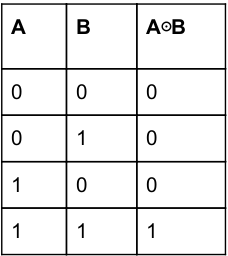
According to the truth table, we have to perform matrix multiplication.

Question 3 |
How many distinguishable permutations of the letters in the word BANANA are there ?
720 | |
120 | |
60 | |
360 |
Question 3 Explanation:
Total distinguishable permutations means no repetition.
BANANA= 6 letters
B is appearing 1 time
A is appearing 3 times
N is appearing 2 times
So, = 6! / (3! * 2!)
= 60
BANANA= 6 letters
B is appearing 1 time
A is appearing 3 times
N is appearing 2 times
So, = 6! / (3! * 2!)
= 60
Question 4 |
The Octal equivalent of the binary number 1011101011 is :
7353 | |
1353 | |
5651 | |
5657 |
Question 4 Explanation:
We have to divide binary number into 3 bit pairs from LSB.
1 011 101 011
1 3 5 3
(1011101011) 2 = (1353) 8
1 011 101 011
1 3 5 3
(1011101011) 2 = (1353) 8
Question 5 |
Let P and Q be two propositions, ¬ (P ↔ Q) is equivalent to:
(I) P ↔ ¬ Q
(II) ¬ P ↔ Q
(III) ¬ P ↔ ¬ Q
(IV) Q → P
(I) P ↔ ¬ Q
(II) ¬ P ↔ Q
(III) ¬ P ↔ ¬ Q
(IV) Q → P
Only (I) and (II) | |
Only (II) and (III) | |
Only (III) and (IV) | |
None of the above |
Question 5 Explanation:

So, (I) and (Ii) are TRUE.
Question 6 |
‘ptrdata’ is a pointer to a data type. The expression *ptrdata++ is evaluated as (in C++) :
*(ptrdata++) | |
(*ptrdata)++ | |
* (ptrdata) ++ | |
Depends on compiler |
Question 6 Explanation:
Normally ++ having higher precedence than * but both are unary operators in C++.
So, the precedence ptrdata++ will evaluate first. So, we are given parenthesis (ptrdata++).
Second precedence is * and finally *(ptrdata++)
So, the precedence ptrdata++ will evaluate first. So, we are given parenthesis (ptrdata++).
Second precedence is * and finally *(ptrdata++)
Question 7 |
The associativity of which of the following operators is Left to Right, in C++ ?
Unary Operator | |
Logical not | |
Array element access | |
addressof |
Question 7 Explanation:
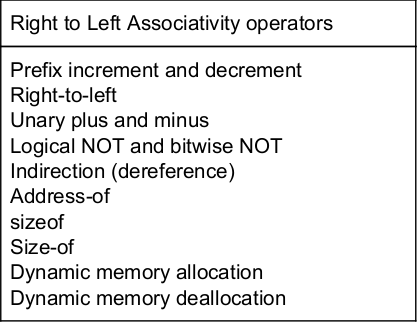
Note: The array element access evaluates from left to right and starts index 0.
Question 8 |
A member function can always access the data in __________ , (in C++).
the class of which it is member | |
the object of which it is member | |
the public part of its class | |
the private part of its class |
Question 8 Explanation:
→ A member function can always access the data in the class of which it is member.
→ Functions within classes can access and modify (unless the function is constant) data members without declaring them, because the data members are already declared in the class.
→ Functions within classes can access and modify (unless the function is constant) data members without declaring them, because the data members are already declared in the class.
Question 9 |
Which of the following is not correct for virtual function in C++ ?
Must be declared in public section of class | |
Virtual function can be static | |
Virtual function should be accessed using pointers. | |
Virtual function is defined in base class |
Question 9 Explanation:
→ Virtual functions are called only for objects of class types, you cannot declare global or static functions as virtual.
Question 10 |
Which of the following is not correct (in C++) ?
Class templates and function templates are instantiated in the same way | |
Class templates differ from function templates in the way they are initiated | |
Class template is initiated by defining an object using the template argument | |
Class templates are generally used for storage classes | |
None of the above |
Question 10 Explanation:
(1) TRUE: Class templates and function templates are instantiated in the same way
(2) FALSE: Class templates differ from function templates in the way they are initiated
(3) FALSE: Class template is initiated by defining an object using the template argument
(4)FALSE: Class templates are generally used for storage classes
(2) FALSE: Class templates differ from function templates in the way they are initiated
(3) FALSE: Class template is initiated by defining an object using the template argument
(4)FALSE: Class templates are generally used for storage classes
Question 11 |
Which of the following is/are true with reference to ‘view’ in DBMS ?
(a) A ‘view’ is a special stored procedure executed when certain event occurs.
(b) A ‘view’ is a virtual table, which occurs after executing a pre-compiled query. code:
(a) A ‘view’ is a special stored procedure executed when certain event occurs.
(b) A ‘view’ is a virtual table, which occurs after executing a pre-compiled query. code:
Only (a) is true | |
Only (b) is true | |
Both (a) and (b) are true | |
Neither (a) nor (b) are true |
Question 11 Explanation:
VIEW is a virtual table based on the result set of a SQL statement.
→ In SQL, a view is a virtual table based on the result-set of an SQL statement.
→ A view contains rows and columns, just like a real table. The fields in a view are fields from one or more real tables in the database.
→ You can add SQL functions, WHERE, and JOIN statements to a view and present the data as if the data were coming from one single table.
CREATE VIEW Syntax:
CREATE VIEW view_name AS
SELECT column1, column2, ...
FROM table_name
WHERE condition;
Note: A view always shows up-to-date data! The database engine recreates the data, using the view's SQL statement, every time a user queries a view.
→ In SQL, a view is a virtual table based on the result-set of an SQL statement.
→ A view contains rows and columns, just like a real table. The fields in a view are fields from one or more real tables in the database.
→ You can add SQL functions, WHERE, and JOIN statements to a view and present the data as if the data were coming from one single table.
CREATE VIEW Syntax:
CREATE VIEW view_name AS
SELECT column1, column2, ...
FROM table_name
WHERE condition;
Note: A view always shows up-to-date data! The database engine recreates the data, using the view's SQL statement, every time a user queries a view.
Question 12 |
In SQL, __________ is an Aggregate function.
SELECT | |
CREATE | |
AVG | |
MODIFY |
Question 12 Explanation:
Aggregate function is AVG. The AVG() function returns the average value of a numeric column.
There are 12 questions to complete.
